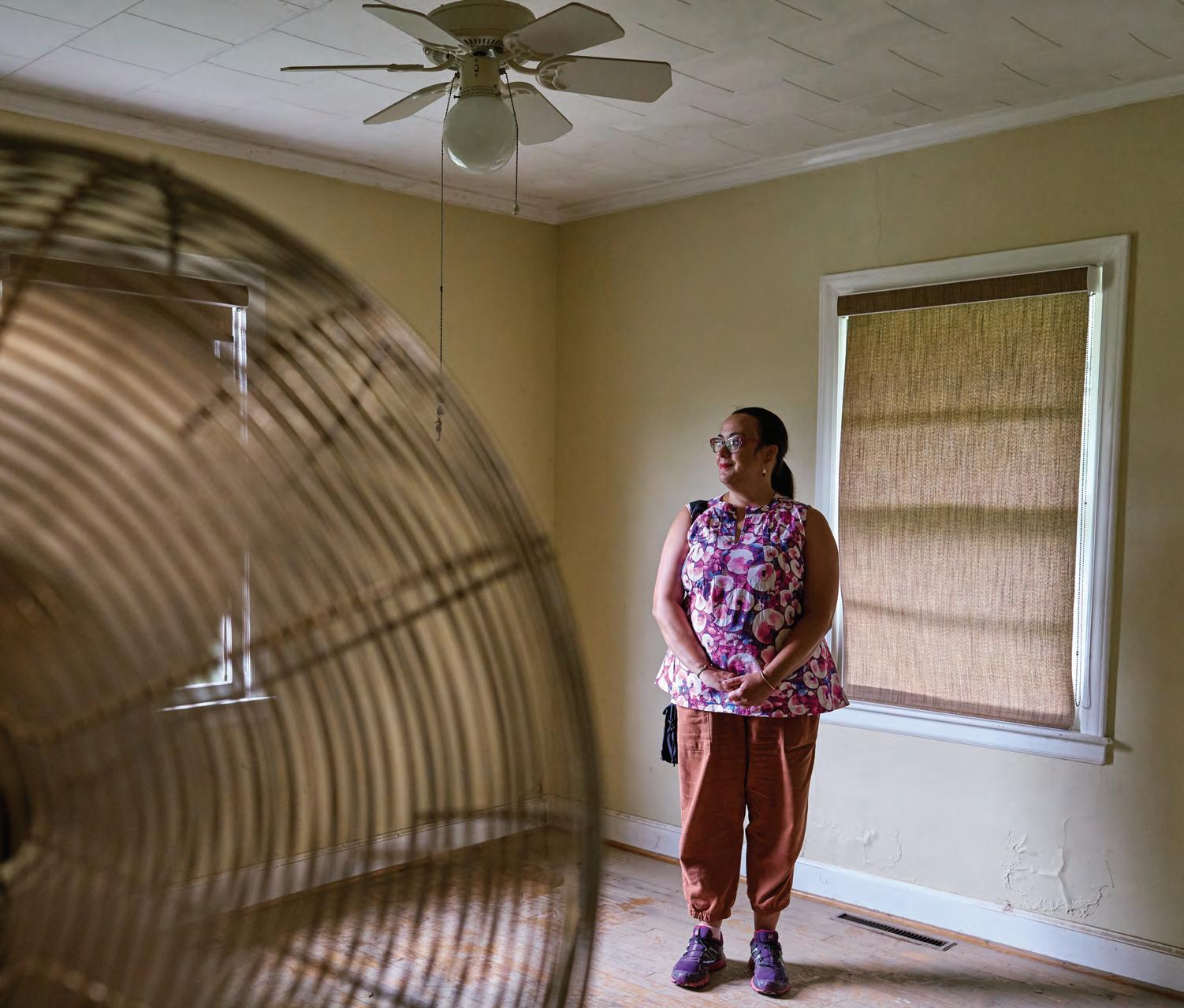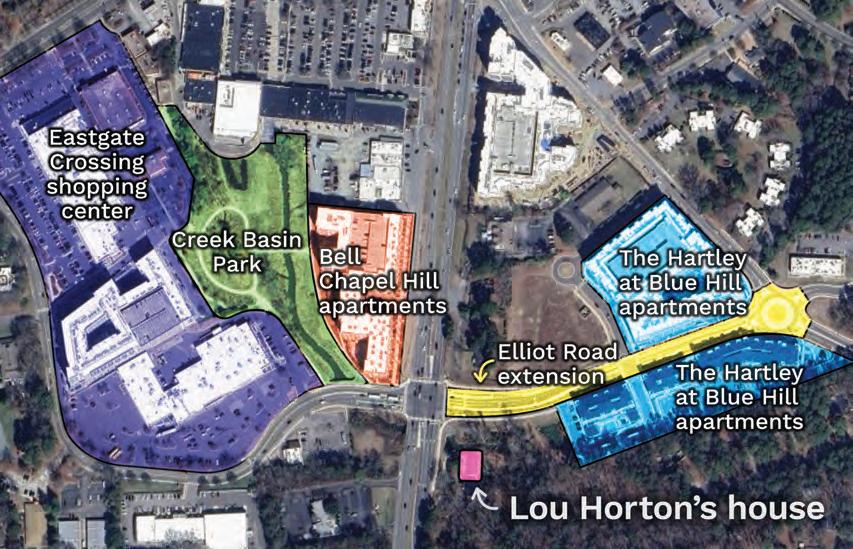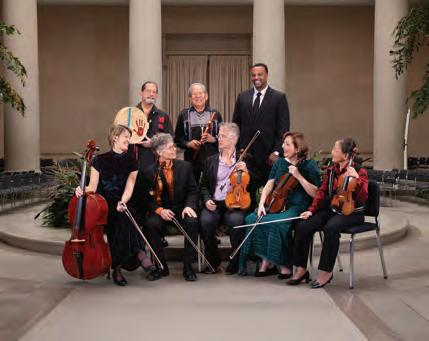August 20, 2025






August 20, 2025









By Lena Geller, p.9



In the immediate aftermath of Tropical Storm Chantal, Chapel Hill residents Lou Horton and Paul Greganti have been displaced and lost nearly all of their belongings. But the long-term reality is harder to confront: They know another flood like this will come.

Vol. 42 No. 17 | August 20, 2025
5 Representative Valerie Foushee's campaign says the congresswoman would turn down money from AIPAC, which poured millions into her primary race in 2022. BY CHASE PELLEGRINI DE PAUR
7 Chapel Hill hopes to expand its successful alternative response program, but longterm funding is uncertain. BY CLAIRE MURPHY
9 Chapel Hill residents Lou Horton and Paul Greganti are part of a growing class of people stuck in homes increasingly threatened by natural disasters—climate refugees who haven’t yet left. BY LENA GELLER
17 Raleigh is gathering community input for potential updates to its noise regulations. BY JANE PORTER
18 "If you listen to the record, you can hear a conversation that is living and breathing in a way," says musician Joseph Decosimo about his new album, Fiery Gizzard BY SARAH EDWARDS
20 An interview with the founders of Raleigh Fest 2025. BY RYAN COCCA
24 Lunch Money: Waygu and pastries at Morning Rolls in Raleigh. BY LENA GELLER
26 Character Studies: Derek Haynes, botanist and social media influencer. BY DANEEN KHAN
27 Character Studies: Carlos Lemus Sr. is Raleigh's #CakeJefe. BY CHLOE COURTNEY BOHL
3 Backtalk 4 Ask INDY 28 Calendar

Publisher John Hurld
Editorial
Editor-in-Chief
Sarah Willets
Lou Horton poses for a portrait in her Chapel Hill home after it was flooded by Tropical Storm Chantal PHOTO BY MATT RAMEY Circulation Berry Media Group Membership/ subscriptions John Hurld Mathias Marchington
Raleigh
Editor
Jane Porter
Culture Editor
Sarah Edwards
Staff Writers
Lena Geller
Justin Laidlaw
Chase Pellegrini de Paur
Report For America Corps Reporter
Chloe Courtney Bohl
Contributors
Mariana Fabian, Jasmine Gallup, Desmera Gatewood, Tasso Hartzog, Elliott Harrell, Brian Howe, Jordan Lawrence, Elim Lee, Glenn McDonald, Nick McGregor, Gabi Mendick, Cy Neff, Andrea Richards, Barry Yeoman
Copy Editor
Iza Wojciechowska
Editorial Interns
Eva Flowe, Daneen Khan
Creative
Creative Director
Nicole Pajor Moore Advertising Publisher John Hurld
Director of Revenue
Mathias Marchington
Director of Operations
Chelsey Koch
Account Representative
Jessica Schell
INDY | indyweek.com
P.O. Box 1772 Durham, N.C. 27702
919-666-7229
support@indyweek.com
To reach INDY staff directly: tips@indyweek.com
919-666-7229
From reader SARAH BEDDINGFIELD via email:
This sounds like an excellent plan. However there are other areas of transit in this town that deserve tweaking that could make substantial improvements in our current traffic situation here, because we are all suffering from old traffic infrastructure with too many personal cars on our roads. I am going to give just one small example of this. I live on Hillandale Road. Hillandale is one of the shortest roads in Durham, yet in the last two to three years it has become a speeding, dangerous overcrowded road. This could be addressed by making a significant change to the current bus route that comes here. Outside of normal residential use, there is almost no reason to use Hillandale Road unless you are going to Duke, or working at Duke, or going to Duke’s clinics down the road, unless you happen to be going to 85, or 147 or going to Riverside High School. Not that many people live out here. So why is every single street like Horton, Guess, Carver, and small residential streets being used as a connector to get to Duke or Duke entities or elsewhere? The bus route makes a loop here. You cannot go directly to Duke from here. You have to go downtown to the transfer station and take the extra time to transfer to another bus to go 10 minutes down the road, which adds a lot of time to commuting. If you are working at Duke as probably most people living out here now are, it takes you so much longer to get to and from work, going to doctor appointments, or whatever. It takes so much longer that people use their cars much more than they might not otherwise. A publicity campaign letting all the people out here know that they can get to Duke faster and more efficiently and changing this one route might not only make more ridership on the bus, but it would save people money and reduce the traffic jams all over this area, which are getting
worse all the time. Transfer stations are economical for the bus service, but if we really want to get everybody as much as possible on our buses to save our environment and keep quality of life here, these kinds of things need to be looked at. Duke is the major employer of Durham, and transit staff need to realize that in order to serve everybody, instead of a particular group of people or a particular area that’s perceived as having a large number of people who need the bus, we need to try to get everyone on the bus by making it convenient. Most urban centers even have school children ride city buses. I did that when I went to school starting in kindergarten. Everyone here also realizes the problems that have been going on for years with our school bus situation, too. I have lived here a long time and I understand a lot about this community and I have absolutely no bias toward anyone in any way. This is a practical suggestion, not a political one. This is what addresses mass transit needs as our population increases and we become a much larger urban area.
From instagram user
:
I’m very pro-transit, but for the same price tag I think we’d be better off adding a dedicated line for this route, increasing frequency, improving bus stop amenities, and keeping the buses free for longer. Hold off on the dedicated lanes and extra long buses (that we don’t have the infrastructure for).
It seems unlikely that this BRT plan would get state or federal funding (at least in the next 3-4 years, if at all), so all of this time and money spent on feasibility and surveys is likely to be an unnecessary waste (need I say light-rail?)
Meanwhile, improving frequency—at least along this
route, if not system-wide—could be implemented very … rapidly. No surveys needed!
Excerpts from instagram user AIDILISMS:
The issue here is that the money being spent on the BRT work HAS to go to transit-related projects because of how the legislation was written.
Part of what transit tax money will go towards is getting popular routes to come every 15 minutes or less. The transit tax can’t be used for regular road maintenance. Kind of like how the affordable housing bond money can’t be used for sidewalks and the park bond money can’t be used for a convention center, the same is true of the transit tax money …
BRT is essentially an express service along this route. That is the intention. They want to choose routes where this and other bike/pedestrian assets won’t collide (i.e., bike lanes) and part of how they are getting this express delivery is the technology that synchronizes the bus to the lights so they don’t get stuck behind red lights as they approach.
Road resurfacing on its own doesn’t qualify for transit tax dollars because the legislation specifically wants to assign the money to increasing PUBLIC transit, not just transit of any kind.
BRT looks like lots of different things based on the existing conditions. This goes for lots of transit technologies and models.
From instagram user DAVIDBRADWAY: Maybe 2026 will be “BRT Summer”?!



These stories are part of our ongoing series, Ask INDY, in which INDY staffers put their expertise (and impeccable taste) to use answering your questions about navigating life in the Triangle.
BY DANEEN KHAN backtalk@indyweek.com
It’s officially back-to-school season, which means families are preparing for (and some kids are dreading) the transition from vacations to academia.
It’s been a rough summer for higher education. The federal administration has cut millions in research funds across the nation, called for the dismantlement of the Department of Education, and cracked down on diversity, equity, and inclusion across public and private universities. Institutions like Brown, Columbia, and Harvard Universities are striking settlements with the Trump administration to restore funding and end federal investigations into alleged antisemitism. In Durham, Duke University is being called on to submit admissions demographics ensuring its compliance with the death of affirmative action.
The last time many university students were in class, they were balancing the spring semester with fears of Immigration and Customs Enforcement (ICE) on campus. In April, Inside Higher Ed reported over 1,800 international students and recent graduates had their legal statuses changed. That month, six students from UNC-Chapel Hill and two students from North Carolina State University had their visas revoked. At Duke, visas were revoked from two students and one alumnus.
With students heading back to school in an equally—if not even more—precarious state for higher education, one reader wrote in:
Which colleges are collaborating with ICE/deportation? Which have clear opposition? How are colleges/universities protecting their international students and staff? Are protections for academic staff different from protections for staff in groundskeeping, kitchen, or janitorial roles?
Seeing how I’m writing this from my UNCCH dorm, it makes sense to start with my home turf. Back in January, Chancellor Lee Roberts announced that UNC will comply with ICE if the agency decides to enter campus. In an interview with The Daily Tar Heel in April, Roberts further explained his comment, saying that UNC as a public institution cannot choose which laws to uphold or which government agencies to comply with under lawful requests.
Duke, which is a private institution, does not appear to have made any public statement announcing its intent to comply with or defy ICE on campus. Administration from both universities released statements voicing support of international students.
In a statement, UNC Media Relations said that student immigration status is protected under the Family Educational Rights and Privacy Act (FERPA) and referred the INDY to UNC Police General Order 00-01R13, which states that all employees must abide by town, state, and national laws. The order also states that employees should not acknowledge or show recognition of uniformed employees in civilian clothing unless addressed first by the undercover employee to “prevent injury or damage to a police operation in the event the employee is working in an undercover capacity.”
UNC has not released information about specific protections for international faculty or staff.
North Carolina Senate Bill 153, also known as the North Carolina Border Protection Act, would block the 17 UNC System institutions—including UNC-CH, NCSU, and North Carolina Central University—from interfering with ICE presence on campuses, in addition to increasing ties between state law enforcement and ICE and allowing legal action against “sanctuary cities” that refuse to cooperate with ICE. (North Carolina does not have any designated sanctuary cities according to the U.S. Department of Justice’s Sanctuary Jurisdiction List, though the Trump administration flagged Durham, Orange, and Chatham Counties as such in May before taking down the list.)
The proposed legislation was vetoed by Governor Josh Stein in June, but that veto could be overturned by Republican majorities in both the state Senate and House.
Across the nation, some students have been pushing for their universities to become “sanctuary campuses” that prioritize protecting undocumented students, faculty, and staff. Students at UNC Asheville protested in favor of sanctuary status in February. Similar anti-ICE protests were held at universities like Duke and UNC, but no local university has made a clear statement of opposition against ICE.
A new Ask INDY topic is posted bi-weekly. Send us your questions at indyweek.com/ask-indy or ask@indyweek.com.
153, also Border Pro17 UNC UNC-CH, Central Unipresence increasing ties and ICE “sanctucooperate with have any according to Sanctuary Trump adminand Chabefore taking vetoed by that veto Republican majoriHouse. students have universities to that priorstudents, UNC Ashesanctuary status protests were UNC, but clear state-

At a town hall in Carrboro earlier this month, Representative Valerie Foushee shifted her position on controversial AIPAC contributions and shared more details with voters about her 2024 visit to Israel.
CHASE PELLEGRINI DE PAUR chase@indyweek.com
U
.S. Representative Valerie Foushee’s campaign says the North Carolina congresswoman will not accept any money from the American-Israel Public Affairs Committee (AIPAC) for her 2026 reelection bid.
That’s a major shift for Foushee—AIPAC, along with its members and super PAC, became her single largest benefactor in 2022 when it poured over $2 million into her campaign and made the race the most expensive Democratic congressional primary in state history.
“You all know that I took the money from AIPAC, but
check to see how much I’ve taken since that time, and check my voting record to see how I have voted and what I have voted for as it relates to the people of Gaza,” Foushee said at at a town hall in Carrboro on August 6 in response to an audience member asking if she “regrets” accepting money from AIPAC or joining a congressional trip to Israel in 2024 to meet with Prime Minister Benjamin Netanyahu.
When asked by the INDY whether Foushee would turn down AIPAC money, a campaign spokesperson said, “AIPAC has not contributed to her campaign since Febru-
ary 2024. AIPAC has not offered financial support in the last 18 months but if offered the Congresswoman would decline. She will not accept AIPAC contributions during the 2026 campaign.”
Campaign finance reports show that AIPAC most recently donated $8,300 to Foushee’s campaign in February of 2024. But in August 2024, a Raleigh resident donated $180 to AIPAC and earmarked the contribution for Foushee, which required AIPAC to pass it on to the candidate. After INDY asked about the August donation, Foushee’s campaign spokesperson said that it was “an individual contribution given through the AIPAC site” but that Foushee “is no longer listed on the AIPAC website as an endorsed candidate able to receive individual contributions.”
In 2022, AIPAC dollars helped Foushee, a longtime fixture of Orange County politics, beat primary challenger and Durham County commissioner Nida Allam, the first Muslim woman elected to office in North Carolina.
At the town hall, Foushee also spoke in more detail about her 2024 meeting with Netanyahu (organized by AIPAC for her and eight other congress members), which she said she doesn’t regret because it was an “opportunity to share with him, face to face, how I felt.”
“Thank you for that question,” Foushee told the audience member. “You just don’t know how many times I’ve been waiting for someone to ask that publicly so I can answer it publicly.”
The congresswoman initially publicly addressed the trip only after INDY broke the news that she was involved.
“We shared our concerns with how the war was being run,” she said at the town hall. “We shared how we were not pleased with what was going on … and I think we made it very clear to him that at least the representatives in that room would not vote for any more appropriations to go out …. Yes, for those of you who read in the INDY that I was sitting straight in front of him, I was, because that’s just where my seat was. But you will note, and you can go back and look, that nine hours after we left that meeting, nego-
Durham County Board of Elections
Tuesday, October 7, 2025
The 2025 Municipal Primary Election for City of Durham Mayor and Council will be held in Durham County, NC on Tuesday October 7th. All precincts, excluding Precinct 26, will be open from 6:30 am until 7:30 pm. Precinct 26 – Rougemont will not be open because no city/town area lies within the precinct boundaries.
17-year-old City of Durham voters who are registered and will be 18 years old on or before Nov. 4, 2025, may vote in the Primary Election.
The following contests will be on the Primary Ballot:*
• City of Durham Mayor
• City of Durham City Council - Ward 1
• City of Durham City Council - Ward 2
• City of Durham City Council - Ward 3
* The primary for these contests will only be required if three or more candidates fle for the respective offce.
Absentee By-Mail: Absentee by-mail voting begins on September 5, 2025. Absentee by-mail ballots can be requested fully online at the following link: https://votebymail.ncsbe.gov/app/ home. Be sure to request your absentee by-mail ballot no later than September 23, 2025, at 5:00 p.m. All absentee by-mail ballots must be returned to the Board of Elections no later than 7:30 p.m. on Election Day.
Election Day: All active polling places in Durham County will be open on October 7, 2025, from 6:30 a.m. – 7:30 p.m. To fnd your Election Day polling place, please use the State Board of Elections Polling Place Lookup Tool at the following link: https://www.dcovotes.com/voters/ voting/polling-locations.
Early Voting: Early voting in Durham County will occur from Thursday, September 18, 2025 –Saturday, October 4, 2025. Hours are consistent at all fve early voting sites and are as follows:
• Weekdays: 8:30 a.m. – 6:00 p.m.
• Saturdays (Sep. 20th and 27th): 8:30 a.m. – 1:00 p.m.
• Saturday (Oct. 4th ): 8:00 a.m. – 3:00 p.m.
• Sundays (Sep. 21st and 28th): 12:00 p.m. – 4:00 p.m.
South Regional Library 4505 S. Alston Ave., Durham North Regional Library 221 Milton Rd., Durham East Regional Library 211 Lick Creek Ln., Durham NCCU Law School 640 Nelson St., Durham Board of Elections 3825 S. Roxboro St., Suite 101, Durham
Voter Registration Deadline: The voter registration deadline for the 2025 Municipal Primary Election is Friday, September 12, 2025 (25 days prior). Voters that miss the registration deadline may register and vote during the Early Voting period. Voters who are currently registered need not re-register. Registered voters who have moved or changed other information since the last election should notify the Board of Elections of that change by September 12th. Party changes are not permitted after the voter registration deadline. For more information, visit our website at https://www.dcovotes.com/voters/registration
Same Day Registration: Voters are allowed to register and vote during early voting. It is quicker and easier to register in advance, but if you have not registered you can do so during Early Voting with proper identifcation. This same day registration is not allowed at polling places on Election Day. For more details on the requirements associated with Same-Day Registration during Early Voting, visit our website at https://www.dcovotes.com/voters/voting/early-voting.
Information regarding registration, polling locations, absentee voting, and other election matters may be obtained by contacting the Board of Elections.
Website: www.dcovotes.com Phone: 919-560-0700
Email: elections@dconc.gov Fax: 919-560-0688
tiations for a ceasefire resumed. Now they did not hold, but they did resume.”
Foushee’s messaging on the war has also changed somewhat since an April 2024 statement when she primarily emphasized Israel’s right to defend itself.
A few months after her trip, she skipped a congressional address by Netanyahu, saying the Israeli government needed to be held “accountable for its actions when necessary.”
The representative has also recently signed on to a letter urging the secretary of state to provide better oversight of the Gaza Humanitarian Fund, the American nonprofit currently responsible for distributing aid.
“Starving civilians are being met with gunfire at aid sites—it’s inhumane and unacceptable,” Foushee posted online last month. “I continue to call for a ceasefire to ensure the flow of aid to the region and safe return of the remaining hostages.”
After the town hall, Foushee announced via social media that she had signed on to cosponsor the “Block the Bombs” act, originally introduced in the spring, which would prohibit the president from selling certain weapons to Israel (“We simply cannot continue to provide the Israeli government with weapons when they are not being used in accordance with international law to maximize the protection of civilians in Gaza,” she wrote).
Foushee’s ultra-blue district contains Carrboro and Durham, which were the first municipalities in the state to pass resolutions calling for a ceasefire (Boone has since become the third). The representative has been named and shamed by council members and protesters alike as they’ve tried to push the buttoned-up political veteran into
a louder advocacy role regarding Gaza.
Despite that apparent displeasure with Foushee, no one emerged to primary her in 2024.
Since 2022, though, her district has been redrawn to cut out several corners of Alamance, Caswell, Granville, and Person Counties, where Foushee garnered thousands more votes than Allam. The district, in addition to all of Durham and Orange, now also contains portions of Chatham and Wake Counties. That may change the path to victory in any potential 2026 primary, for which candidate filing starts this December.
During the town hall, Foushee also said that she has long supported anti-gerrymandering measures like independent districting for congressional seats but supports blue states like California that are considering redrawing their congressional maps to favor Democrats in response to Texas Republicans’ aggressive seat grab at the behest of President Trump.
“I don’t advocate for anybody breaking the law, but what I do believe is that once the rules of engagement have been announced, that everybody gets to play by the same rules,” she said to applause. “And if [Republicans are] going to use redistricting to beef up your numbers in the House, then those blue states should use the same rules.”
And to close the town hall, Foushee urged her constituents to keep contacting her office.
“The more I hear from you and I can see that there’s consensus, that’s how I’m going to vote,” she said. “But just like some Republicans can be replaced in 2026, if I’m not serving you the way you feel that you need to be served, then you get that opportunity to make sure I don’t return in 2026.”

Gaza. displeasure with primary her district has corners of and Person garnered thouThe district, Orange, Chatham change the 2026 pristarts this also said anti-gerrymandistrictsupports are considcongressional maps to Texas grab at the breaking the once the announced, the same if [Repubredistricting to beef then those rules.” Foushee contacting I can see I’m going some Repubif I’m not you need opportuni2026.”

Chapel Hill leaders hope to expand CARE’s hours of operation and geographic reach. But long-term funding for the alternative response program remains uncertain amid widespread federal cuts to mental health support services.
BY CLAIRE MURPHY backtalk@indyweek.com
Over 50 years ago, Chapel Hill became one of the first cities in the country to send clinicians along with police officers to respond to people experiencing a mental health–related crisis.
In May 2024, the city expanded this approach, launching a pilot program that dispatches mental health specialists to respond to incidents without police. The team also includes a peer support specialist—someone with their own lived experience with mental health struggles—to respond to calls. During its first year, the Crisis Assistance, Response, and Engagement team—or CARE—has had great success, responding to almost 1,300 events and significantly reducing the number of arrests and forced hospitalizations that would have occurred with traditional police response, according to the Chapel Hill Police Department, which oversees the program.
City leaders hope to expand CARE’s hours of operation and geographic reach to neighboring jurisdictions like Carrboro. But long-term funding for the program remains uncertain amid widespread federal cutbacks to mental health support services.
“There’s really a need for folks who are peer support, who are medically mental health trained in our communities, our neighbors’ communities, all across the country,” says Heather Palmateer, a crisis counselor on the CARE team.
Since the 1970s, Chapel Hill’s Crisis Unit has been partnering police officers with clinicians to address emergencies involving a mental health component.
While it was originally envisioned to address juvenile and family altercations, the team quickly grew to be an integral part of the police department, responding to everything from domestic abuse and stalking to behavioral health concerns.
Following the George Floyd protests and police reform movement of 2020, Chapel Hill began envisioning another model, one where practitioners would respond to mental health emergencies in lieu of law enforcement.
“We know there’s research that traditional public safety, fire, EMS, and law enforcement are not the best approach to mental health cases,” says Kirby Saunders, director of Orange County Emergency Services, which routes all 911 calls in the county.
Traditional first responders lack the resources and training necessary to properly deescalate these types of calls, Saunders says. Police and 911 call operators’ priorities are to stabilize the caller and transport them to an appropriate care facility, which doesn’t resolve the root of the problem, he says.
“We [began] looking more holistically at building resources and capabilities to meet the individual, where they may be, when they may be in need, with a more holistic approach,” says Saunders.
The town council organized a community task force to improve racial equity and identify corresponding gaps in behavioral health care and public safety.
The result was the creation of CARE: a four-person mobile crisis unit embedded within the police department that offers deescalation techniques and trauma-informed support during mental health crises.
Sarah Belcher, who oversees the Chapel Hill Crisis Unit and CARE, says that 98 percent of the calls they have responded to in the last year did not result in arrest or hospitalization. The program provides more “natural, community-based support,” Belcher says.
Cities nationwide have instituted non-police alternate response programs, but Chapel Hill is among the relatively small number that includes practitioners with their own
lived experience with mental health challenges to respond to people in crisis.
Jennifer Melvin acts as CARE’s peer support specialist. She knows well what it’s like to be on the other side of the phone calls she answers everyday.
“When someone shows up that’s actually been through what you’ve been through, or knows about it and can assist you with it, [it] makes you more relaxed and more willing to receive help,” says Melvin.
Melvin has battled depression since she was a teenager. After surviving an abusive relationship and sexual assault, she developed PTSD from the experience, which she says later led to addiction.
After 17 years in recovery, Melvin wants to be the resource she wishes she’d had.
“I love helping people because I’ve been in [the] place where you feel lost, unheard, you can’t move,” says Melvin. “The reason I think I can assist people with what they’re really going through is because I understand.”
The CARE team also includes two crisis counselors—one of whom is embedded in the Orange County 911 call center, to help identify CARE-eligible calls—and an EMT. All members respond to calls Monday through Friday, 8:00 a.m.–4:30 p.m.
Over the past year, the close-knit team— and its now distinct white mobile crisis van and blue logo—has become somewhat of a fixture in Chapel Hill.
“When they see us coming, they walk straight up to us and just want to talk,” says Melvin.
“We build a lot of rapport with the people we deal with and we talk to them with ease.”
Palmateer is a registered clinical social worker experienced in deescalation techniques. As one of the crisis counselors, she often witnesses what might be the most challenging moment in a person’s life.
“We see folks in a very vulnerable place,” she says. What keeps her going when the job gets overwhelming are “the moments where you can really feel when it’s clicked with someone, and you know that you’ve gained their trust.”
When a request comes into the 911 call center, the call taker will ask a specific set of questions, known as “call determinants,” to establish if the call has a mental health component and doesn’t appear to have the potential for violence.
If it meets the criteria, CARE will be dispatched.
Orange County uses about 60 different call types to classify an emergency call and corresponding police dispatch protocol. Only
three of these call types are CARE eligible.
Because the program is in its pilot period until May 2026, Saunders says call takers are still learning the protocol and getting accustomed to dispatching CARE. In the interim period, CARE also engages in self-dispatch, listening in to 911 calls that may have mental health–related components and responding accordingly.
“Unfortunately, there’s not a real easy way to build a protocol to tell our telecommunicators ‘Do this, if this,’” says Saunders. “We’re working through a lot of activities to encourage and build relationships and an understanding of what the clinician can do.”
The team averages about 100 calls a month, according to internal data, a substantial response for the size of the community.
Of the 1,300 incident responses CARE fielded in its first year, only about 4 percent of events required hospital transport for behavioral health care and 3 percent transport for a medical emergency.
“At the end of the day, that’s four or five or 200 less people that had to call for an ambulance or be taken to the emergency department,” says Saunders. “That’s 200 other chances that someone else needed [assistance] and they had the resources available quicker.”
Saunders says the success of the team has allowed the city to divert more resources toward other emergency assistance efforts, which in turn has supported CARE’s effectiveness as a unit.
“They’re the best of the best in their line of work,” says Saunders. CARE is shining a “bigger light” on the barriers and challenges people experience on a daily basis, which helps both normalize and reinforce the importance of mental health awareness, he adds.
With the initial success of the program, supervisors are looking to expand CARE’s coverage countywide next year.
“In the pilot stage, we’re only serving the town of Chapel Hill, but moving forward, our goals are to see this program grow out,” says Belcher. “We are right now having conversations with another local agency, the Carrboro Police Department, to start that extension.”
Expansion is ultimately dependent on securing future state funding.
For the past year, CARE has been supported by a $580,000 grant from the North Carolina Department of Health and Human Services, much of that federally allocated. City officials are concerned about where

CLAIRE MURPHY
“We know that handcuffs and hospitals aren’t the solution for most people when they’re in crisis.”
future funding will come from, with federal cutbacks to mental health care causing the closure of several long-standing alternate response programs across the county.
“Certainly there’s a risk, given what is happening in Washington, that we are all a bit on edge over,” says Saunders. “When the rug is pulled out from programs that impact local communities, local communities are going to be forced to make very difficult financial decisions.”
To help support future investment, the UNC School of Government’s Criminal Justice Innovation Lab is completing an evaluation of the pilot program. The report will quantify specific benchmarks of success and compare the results to other alternate response programs in the area—like Durham’s HEART initiative.
“The state is not going to be able to sustain this program for an indefinite period of time,” says Saunders. “But this gives us an opportunity to evaluate the need, the demand, the opportunities, and the impacts that this team and resource can have to
justify investments in the future.”
Orange County is also building a crisis diversion facility for individuals experiencing behavioral health crises, who normally would be diverted to a hospital or jail.
In April, commissioners approved the purchase agreement for the property that will serve as the future site, furthering the county’s efforts to build out comprehensive behavioral health services.
Programs like CARE are oftentimes one of the only ways individuals in need can get this kind of treatment without the consequences that can come with a traditional law enforcement response.
“There’s very few resources to solve the problem, and that has been our only resource,” says Saunders. “We know that handcuffs and hospitals aren’t the solution for most people when they’re in crisis.”
If you or someone you know is facing a mental health crisis, immediately call, text, or chat with the 988 Suicide and Crisis Lifeline or dial 911 for emergency support.

Lou Horton lives in a floodplain amid growing development near Chapel Hill’s Eastgate Shopping Center. For her and her husband, Tropical Storm Chantal was both a singular catastrophe and the yearslong culmination of watching their situation grow more precarious.
BY LENA GELLER lgeller@indyweek.com
In the middle of the night on July 6, as Tropical Storm Chantal unleashed on Chapel Hill, Lou Horton and her husband Paul Greganti huddled in their attic with their three cats.
The couple’s one-story house is not positioned well for such an event. It sits in a hollow where the land drops sharply away from Fordham Boulevard, accessible only by driving down what is essentially a steep driveway off that road. You can barely see their rooftop from the street.
Their house also sits on the banks of Booker Creek, a half-mile downstream from Eastgate Shopping Center.
The night of Chantal, the creek became a conveyor belt for debris from Aldi, Dollar Tree, and other Eastgate businesses. From their attic, Horton and Greganti could hear but not see what was rushing past in the darkness.
“That was the scariest part,” Horton says. “We heard things flowing by and smashing against the house. Anything that flowed by could’ve been a dumpster or a tree or a telephone pole crashing into our house and killing us.”
For Horton and Greganti, the flood was both a singular catastrophe and the culmination of years spent watching their situation become more precarious. Trapped in a house no one else will buy, watching new apartment complexes spread upstream while their own land erodes into the creek, they’re part of a growing class of people stuck in homes increasingly threatened by natural disasters—climate refugees who haven’t yet left.
Earlier that day, around 4 p.m., Horton had moved her car to higher ground behind Squid’s Restaurant and pressed Greganti to do the same with his truck. Flash flood warnings had been pinging her phone all day.
Greganti declined, saying his truck was out of gas. The house, built entirely of cinder blocks in 1952, had never flooded inside in the 22 years since he bought it. He’d been watching the radar all day and was convinced they’d be fine. Horton offered him $40 for gas to move his truck. He
said no. She gave up and fell asleep, weary from working her jewelry booth at the Festival for the Eno all weekend.
Greganti woke her up a few hours later, at 8:10 p.m.
“It’s flooding,” he said. He’d already moved his truck and hoisted the lawnmower onto the porch.
Horton watched out the window as water crept up the side of the house. When it rose to less than a foot from the sill, she rolled down the shades.
“I was starting to get seasick,” Horton says.
She called her brother.
“I was like, ‘Yeah, so, I’m gonna die. I’m probably gonna die,’” Horton recalls telling him.
He urged her to call 911. She tried. No one answered. The emergency system was overwhelmed with nearly 8,000 calls that night, according to Alex Carrasquillo, communications manager for the Town of Chapel Hill.
Horton and Greganti moved to the attic soon after. The smell of gasoline, from their lawnmower that had washed
off the porch, filled the air as the hours passed.
Around midnight, Greganti’s phone rang. Horton answered. It was a first responder.
“Are you in your house?” the first responder asked. “We’re coming to rescue you.”
“You have to rescue our neighbors first,” Horton responded. Horton and Greganti share Bypass Lane with just one other household—an elderly couple who lives with their three adult children, according to Horton.
The responder assured Horton they were talking to the neighbors’ son; that’s how they’d known to call Greganti. “We’re coming to get you,” the first responder said. “We just have to get a boat here.”
But the rescue never materialized. No one came to get them, and they didn’t receive another call.
The water receded around 1:30 a.m. At its height, it had reached two feet inside their house. Horton and Greganti climbed down from the attic and met their neighbors in what remained of their shared driveway, comparing notes.
The neighbors hadn’t even realized Horton and Greganti were home. The adult children had gone to move their cars soon after Greganti did and by the time they returned to the intersection of Bypass and Fordham, they couldn’t make it back through the floodwaters, according to Horton. After hours waiting by the side of the road, they’d been spotted by Chapel Hill police, who called for a water rescue upon learning their parents were trapped inside. But the boat the first responders brought had no motor, and they determined the water was moving too quickly to use it.
Carrasquillo confirmed the attempted rescue to the INDY, writing that firefighters had tried to perform a res-


cue but “could not safely do so in the fast-moving water.”
In the immediate aftermath of the flood, Horton and Greganti have been displaced and nearly all of their belongings destroyed. Greganti has FEMA flood insurance, but it currently only covers the structure, not personal property.
Horton’s livelihood is also on indefinite hiatus. She makes money selling handmade copper jewelry and renting out a kiln in her backyard. The night of the flood, her shed full of jewelry supplies floated 200 feet before crashing into a neighbor’s car. Her packaging and shipping materials were swept away. Over a month later, the kiln is still airing out.
Greganti is disabled and not currently working; Horton provides their only income. With scant savings to cushion the blow, they’re scrambling to figure out what comes next.
But the long-term reality is harder to confront. The couple knows another flood like this will come. And they have nowhere to go.
Horton happens to be the great-granddaughter of the dairy farmers who once owned the swampy land where Eastgate Shopping Center was built in 1958. That has nothing to do with the fact that she lives next to it.
“I did not inherit anything,” she wrote in an email to the INDY. “I’m a millennial, I’m poor as shit.”
The house where she and Greganti live sits in a FEMA-designated floodway—Zone AE, the highest-risk flood zone where water naturally flows during major flood events. This designation was not in place when Greganti purchased the property for $121,000 in 2003, drawn by its affordability and natural setting on just under a half-acre. At the time, it was designated generally as being in a 100-year floodplain.
“The meaning was unclear but not something that seemed threatening or devastating,” Horton says.
Over the years, they’d experienced some flooding in the crawlspace but nothing that threatened the living space of the house. In October 2018, FEMA updated its maps, designating their property as part of the floodway.
Unrelated to the new FEMA designation, Horton and Greganti put their house on the market that year. Major changes were coming to the area surrounding Bypass Lane after a 180-acre site, known as the Blue Hill District, had been rezoned in 2014 to encourage dense, mixed-use development, and Horton was growing worried the development would increase the risk of flooding. They left the house on the market for two years. There were no takers.
Then came the wave of new development. In 2021, Chapel Hill began construction on the Elliott Road Extension, a project that would connect South Elliott Road to Ephesus Church Road, cutting through the middle of Bypass Lane. The stated goal of the extension was to improve connectivity within the Blue Hill District, envisioned to be a walkable “live-work-play” environment.
Around the same time, new apartments began sprouting up throughout the district. Straight up the hill from Horton and Greganti’s backyard, The Hartley at Blue Hill—414 luxury apartments across 12 buildings, plus a 500-space parking deck—replaced The Park at Chapel Hill, which had offered some of the town’s last naturally affordable housing. Across the street, Ram Realty began construction on Bell Chapel Hill, a 273-unit complex that would reduce an area where water naturally collected by 20 percent.
As part of accommodating the new development, the town poured money into stormwater improvements, including a $1.1 million project to expand the floodplain between Eastgate and South Elliott Road, creating more space to hold water during storms.
The Blue Hill District’s stormwater infrastructure is rated for 100-year storm events: storms that statistically have a 1 percent chance of occurring in a given year. Chantal—a 500- to 1,000-year storm, per meteorologists—overwhelmed its capacity.
But these classifications—technical terms based on historical data—increasingly fail to capture the new climate reality. Danielle Spurlock, a UNC professor specializing in

land use and environmental planning, says this mismatch between infrastructure design and extreme weather is becoming the norm.
“In this case, I would say [the town] did the most they could do, but because of climate change, it’s not gonna be enough,” Spurlock says. “That 1,000-year storm? It’s not gonna be another 1,000 years before it shows up again.”
Spurlock adds that municipalities typically approach stormwater management parcel by parcel rather than thinking cumulatively about watershed impact. Even when developers follow all the rules, the collective effect of more impervious surfaces can overwhelm downstream areas during extreme weather events, she says.
When asked about the impact of the town’s development
decisions on flooding at Bypass Lane, Carrasquillo wrote in an email that “6 and 7 Bypass Lane are entirely within the floodway which is the highest chance area for flooding and this was a historic storm in our community.” The Elliott Road Extension “was designed and built to meet all applicable stormwater ordinances,” Carrasquillo wrote, and all projects in the Blue Hill District “are required to build stormwater systems that manage some of the pre-existing impervious surface on the site.”
From where Horton stands—on increasingly eroding banks—the technical compliance means little. Over the past five years, she and Greganti have lost significant portions of their property to the creek while flooding has become more frequent.

“I can’t live here,” she says. “It’s ruined. There’s nothing I can personally do to make this land safe.”
Parsing the impacts of a historic storm from those of upstream development isn’t straightforward. It’s clear from aerial imagery that there are significantly more impervious surfaces and fewer trees in the watershed. It’s harder to say how severe the flooding the night of July 6 would have been without those changes.
What’s certain is that storms are getting worse and the people who can least afford to relocate are trapped in harm’s way.
“We have done so little to protect the individual homeowner within the system,” Spurlock says. “We’ve depended on these very ecologically vulnerable areas to provide affordable housing.”
The system, she adds, “is acting according to its design. The design was going to place them at risk, and we placed them at risk. We said that’s a risk we’re okay with—that’s on that individual homeowner. And we don’t give them a pathway out.”
Nine days after Tropical Storm Chantal, ten volunteers from the disaster relief group Baptists on Mission make an hour-drive from Thomasville to Bypass Lane.
Horton and Greganti aren’t home. They’ve been staying with Greganti’s sister in Raleigh. Earlier in the week, Horton had seen a flyer at a disaster relief center in Carrboro and registered her address. She figures this is how the Baptists on Mission knew to come.
The volunteers gather in a circle and join hands to pray before getting started. Then they get to work. The crew’s leader, Adrienne Cromer, has a no-nonsense attitude and a brisk benevolence about her. She does a walkthrough of the house alone first, then waves the others in.
“There’s gonna be mold growing under these floors,” Cromer says. “I can smell it.”
Outside, Horton and Greganti’s belongings lay scattered across the yard, waterlogged and sticky from the humidity: lamps and wooden furniture; metalworking tools, sketchbooks, and balls of yarn; an ironing board; baking pans. Pants and shirts lay flat on the grass like a rapture scene.

“Anything that looks artsy goes right here,” one volunteer calls out, carefully placing a piece of Horton’s copper jewelry into a plastic bin.
Around the side of the house, the banks of the creek are piled high with fallen branches and garbage from Eastgate. It looks like someone TP’d the trees with plastic shopping bags.
During the flood, six dumpsters floated past Horton and Greganti’s house, Horton says. OWASA crews came a few days later to haul them away—as well as an additional one that had lodged against a culvert under Fordham Boulevard.
The Baptists on Mission work into the afternoon, hauling bigger items from the house—a piano, an organ, a furniture set Horton had recently inherited from her grandmother—and piling them into a dump trailer Horton borrowed from a friend. The next day, Horton’s dad drove the trailer to a landfill and paid $56 to dispose of it.
Horton can’t see any reliable way to prepare her property—or herself—for the next big storm.
She’s attempted some DIY erosion control over the past few years, but the flood tore up the dogwood tree, gardenia bush, and weeds she’d been trying to cultivate to hold the eroding bank. The larger trees that remain present their own dilemma—Horton and Greganti fear them falling on their house, but cutting them down would accelerate the erosion further.
She’s looking into expanding their flood insurance to cover personal property, but that takes time and money they don’t have right now and also feels somewhat futile: Insurance won’t bring them back to life if they drown in the next storm.
When it comes to their physical safety, the only protection is knowing when to evacuate, but official systems offer limited help, Horton says. Flash flood warnings are sent out constantly for their area; Horton and Greganti aren’t going to evacuate for all of them.
And while Orange County issues evacuation orders through its OC Alerts system during predictable floods, flash flooding presents unique challenges, according to Wil Glenn, Orange County’s Community Relations Director.
“Unlike a riverine flooding scenario or dam failure where a river floods out of its banks in a predictable fashion, flash flooding is nearly impossible to predict with the accuracy necessary to affect a coordinated evacuation,” Glenn wrote in an email to the INDY
Ahead of Chantal, the county issued a voluntary evacuation notice for communities within the inundation area of the Lake Michael Dam. But by the time the need for evacuation in other areas became clear, it was too late to issue a mass order, as “sending a general notice to evacuate without context of the safe routes could have potentially made the situation worse by putting residents on flooded roads,” Glenn wrote.
With no reliable early warning system, Horton says she’s found herself grasping at anything that might offer guidance. The night of the storm, she’d even half-wondered if the full moon might make things worse—something about the tides, she reasoned.
“We have to read the tea leaves and say, ‘Hey, do you think it’s going to flood?’ ‘I don’t know.’ ‘Should we move our cars?’ ‘I don’t know,” she says. “This is how broken it is. It’s like, why don’t I just deal myself a little tarot spread?’”








“I canʼt live here. Itʼs ruined. Thereʼs nothing I can personally do to make this land safe.”


















































Sep 3 | 6:30 PM
Free Concerts Every Wednesday in September
Shana Tucker Sep 10 | 6:30 PM Kenny Sharp
Sep 2–Nov 25 | Rubenstein Arts Center Gallery Miler Lagos: The Merx Tree
Sep 2 & 4 | Ruby Lounge Avital Meshi: Meet GPT-ME
Thu, Sep 4 | Page Auditorium
Atsuko Okatsuka
Sat, Sep 6 | Baldwin Auditorium Rachel Barton Pine with Gilles Vonsattel, piano
Sun, Sep 7 | Page Auditorium
Sudan Archives
Sep 25 26 | von der Heyden Studio Theater
Eiko Otake & Wen Hu What Is War?

Sat, Sep 27 | Baldwin Auditorium Takács Quartet with Jordan Bak, viola
Sep 17 | 6:30 PM Dior Ashley Brown
Oct 2 4 | The Fruit nora chipaumire: Dambudzo
Oct 3 Nov 2 | Duke Chapel Día de los Muertos Ofrenda

Oct 9 10 | von der Heyden Studio Theater Wanjiru Kamuyu: Fragmented Shadows
Sat, Oct 11 | Baldwin Auditorium Trio con Brio Copenhagen
Tue, Oct 14 | Duke Chapel The King’s Singers
Fri, Oct 24 | Baldwin Auditorium Conrad Tao
Sat, Oct 25 | Reynolds Industries Theater Morgan Freeman’s Symphonic Blues Experience





Sep 24 | 6:30 PM Denitia
Sun, Nov 2 | Baldwin Auditorium Leonard Elschenbroich, cello with Alexei Grynyuk, piano
Sat, Nov 8 | Baldwin Auditorium The Ciompi Quartet: Cultural 15 | Reynolds Industries Theater

Max Roach at 100 Tyshawn Sorey Trio & Sandbox Percussion
Save up to 20% when you book four or more shows in the season!
October 25 | 7:30 PM Reynolds Industries Theater
Guided by Morgan Freeman andfeaturing artists from Ground Zero Blues Club backed by a chamber orchestra, this performance celebrates the Blues’ legacy, roots, and spirit through cinematic storytelling and unforgettable live music. Limited tickets remain for this event.
Dec 4 6 | Reynolds Industries Theater
Taylor Mac’s Holiday Sauce












Sat, Jan 17 | Duke Chapel
The Revival: It Is Our Duty
The Fire Ensemble, Led by Troy Anthony
Fri, Jan 23 | Baldwin Auditorium Akropolis Reed Quintet
Fri, Jan 30 | Reynolds Industries Theater time/life/beauty
Michael Sakamoto & Paul D. Miller aka DJ Spooky
Fri, Feb 6 | Reynolds Industries Theater
Julia Keefe Indigenous Big Band
Sat, Feb 14 | Baldwin Auditorium Cuarteto Casals


Feb 21 22 | Reynolds Industries Theater National Dance Theatre Company of Jamaica
Sat, Feb 21 | Baldwin Auditorium The Ciompi Quartet: Memories and Aspirations
Feb 27 28 | von der Heyden Studio Theater The Treachery of Sounds Theatre of Music
Mar 5 6 | The Fruit Kayfabe by Josh Rice






Sun, Mar 8 | Baldwin Auditorium Manhattan Chamber Players
Thu, Mar 19 | Reynolds Industries Theater Marc Ribot: Reframing Dylan
Sat, Mar 21 | Page Auditorium
Shadow Cities
Ephrat Asherie Dance with Arturo O’Farrill

Sat, Mar 28 | Baldwin Auditorium
John Scofield Trio featuring Vicente Archer and Bill Stewart
Apr 2 3 | Reynolds Industries Theater Bear Grease: The Musical LightningCloud Presents









































Raleigh is gathering community feedback for potential updates to its noise regulations; meanwhile, a judge ruled that parts of its nightlife permit ordinance are unlawful.
BY JANE PORTER jporter@indyweek.com
The City of Raleigh has been struggling with regulating noise since you could buy a cup of coffee for a dollar at the Morning Times—or even before. And earlier this month, a Wake County Superior Court judge ruled that parts of the city’s nightlife permit ordinance—a separate but related regulation from Raleigh’s noise ordinance—are illegal after a local bar owner sued the city over it.
But even before that judgment came down, officials were considering making changes to the “Turn Down the Sound” rules, and the city is taking public comments to help with the process.
Julia Milstead, a spokesperson for the City of Raleigh, told the INDY that the ruling on the nightlife ordinance “does not impact the engagement we’ve been doing regarding the noise ordinance.”
In 2023, after much debate, Raleigh adopted new rules to rein in noise and disruptive partying mainly in downtown’s entertainment districts, including Glenwood South. The rules, which went into effect in February 2024, required a $500 initial fee for nightlife permits for businesses selling drinks and providing entertainment after 11 p.m. and a $100 renewal fee annually. Additionally, establishments that received noise citations had to stop “outdoor amplified sound” for 24 hours and pay a $500 fine for a first offense, a $2,500 fine for a second offense, and a $5,000 fine for a third offense.
Business owners complained about being unfairly targeted under the new rules since they only applied to businesses with the nightlife permit. Dan Lovenheim, who owns several bars on Glenwood South including Alchemy, The Avenue, and Milk Bar, filed a lawsuit

against the city in February of last year.
Along with the adoption of the nightlife permit, the city amended its noise ordinance to require commercial establishments that receive noise citations to be measured by a “reasonable person standard” rather than a specific decibel level.
Then, in January, the city strengthened the rules to enforce turning down the sound. Businesses had to comply or risk another citation, with their only recourse being to appeal the citation to the city manager’s office rather than the police department.
Two weeks ago, Judge Paul A. Holcombe III issued an order stating that the city’s nightlife permit ordinance conflicted with the state’s ABC laws, writing that requiring nightlife permits is “unlawful, invalid and void as being without authority and inconsistent with preemptive, uniform system of regulation of ABC permittees” and that parts of the ordinance are “illegal, void and unenforceable” under state law.
“Since receiving the order, the City has taken steps necessary to comply with the court’s order while it considers all options,” Milstead wrote to the INDY in an email. “The City is assessing adjustments to the nightlife ordinances to address the court’s concerns, as well as other potential options.”
The INDY requested data from the Raleigh Police Department about how many noise complaints the city has received, and where, in 2025. We will update this story online when we receive it.
At a May city council work session, the city’s leaders received a Sociable City Assessment report from an independent consultant, the Responsible Hospitality Insti-
tute (RHI), about how it could improve its noise policy. The report, commissioned in early 2024 and focused specifically on the downtown districts around Fayetteville Street and Glenwood South, seemed to strike a chord with the mayor and some council members.
In the report, the consultants suggested revising the noise ordinance and using a third-party mediator to facilitate a new community engagement process with the business community, “between which lies a chasm of mistrust,” the report states. It suggests potentially exploring an alternative enforcement agency or civilian entity (i.e., not the police department) to be in charge of noise enforcement, revisiting the “reasonable person standard,” and implementing a citywide 311 phone system for tracking complaints. Finally, it states, creating a “night manager” position and an “office of nighttime economy” has become “the gold standard in North America to ensure long-term sustainability.”
“When I read the sociable city study, it said a paradigm shift is required,” said Raleigh mayor Janet Cowell at the city’s Safe, Vibrant and Healthy Communities Committee meeting later that month. “Everything in that report resonated to me that that is the right approach.”
The council members agreed to give city staff time to come up with actionable recommendations on the issue, potentially this month after the council returns from its summer break.
Meanwhile, the city launched its online survey August 1; there is currently no end date, but city staff will eventually report back to the council “and get further direction on any continued engagement efforts,” according to Milstead.
JOSEPH DECOSIMO: FIERY GIZZARD
Dear Life Records | August 15, 2025
To make new release Fiery Gizzard, Durham folklorist and musician Joseph Decosimo enlisted a group of friends far and wide for a generative collaboration.
BY SARAH EDWARDS sedwards@indyweek.com
When Joseph Decosimo was 16, his dad drove him from Chattanooga, Tennessee, to Warren Wilson College’s famed Swannanoa Gathering and dropped him off.
The annual folk music and arts conference wasn’t his first rodeo—Decosimo had been toying with a banjo since seventh grade. But he stood out in a room of adults. A Greensboro musician, Steve Terrell, saw him and asked where he’d rolled in from.
“There are a few people around where you live that you could just go and hang out with,” Decosimo recalls Terrell saying, pulling out a Rolodex and jotting down the names of a few old-time musicians in Tennessee’s Cumberland Plateau area. One of them—Charlie Acuff, an octogenarian fiddler and, incidentally, cousin to Roy Acuff, aka the “King of Country Music”—became somewhat of a mentor to the high schooler.
“My dad had got me a tape recorder,” Decosimo says, recalling his visits to learn from and document Acuff’s music. “I was stumbling into being, like, a folklorist, just by sheer interest in music in East Tennessee.”
“The first time I visited him, he gave me a tape,” he continues. “It was called Left Handed Fiddler, because he was a left-handed fiddler, and I went home and just, like, learned every tune on it.”
On August 15, Decosimo’s latest album, Fiery Gizzard, releases via Philadelphia-based label Dear Life Records. As with previous albums, this release draws on a deep catalog of fiddle and banjo standards from throughout the Appalachian South, sieving old sounds through playful new input

and a generative community sensibility.
We’re talking on Decosimo’s screened-in front porch, surrounded by the ever-present pitch of summer bugs. Not surprisingly, it’s a space he and his banjo have spent plenty of time in.
“In order for our kid to sleep at night, this is where you end up sweating it out,” he says. “Sitting and messing with stuff and coming up with new ideas.”
Years after his trip to Swannanoa, a few things have changed: Decosimo, 43, is now a longtime resident of Durham with a family and a trifecta of degrees from UNC-Chapel Hill, including a folklore PhD.
But he’s still a musician, tangling with the sounds of the past. The long-ago moment of Rolodex kismet led not just to a friendship with Acuff but, down the road, to years of study with old-time virtuoso Clyde Davenport, a fellow native of the Cumberland Plateau.
Davenport, who died in 2020, is responsible for preserving a vast repertoire of regional music that Decosimo, in kind, now passes on to students and fellow musicians.
Fiery Gizzard follows two solo albums and several collaborative projects. This album, as Decosimo tells it, was largely inspired by the musicians he regularly jams with, about half of whom are local. On the album, that bill rounds out out with the much sought-after fiddler Steph Coleman (Nora Brown), guitarist Jay Hammond, multi-instrumentalist Matthew O’Connell, bassist and producer Andy Stack (Wye Oak), horn player Kelly Pratt (Beirut, David Byrne), Libby Rodenbough (Mipso, Fust), Joseph O’Connell (Elephant Micah), and the experimental artist Cleek Schrey.
“[The process came] out of playing with people and seeing what old tunes make sense in these different configurations,” says Decosimo. “What was the material that we could sink our teeth into and jam in a way that was responsive and not thoughtless?”
That attunement comes through on Fiery Gizzard like a live wire, as the album shifts comfortably between tracks anchored by vocals (“I Had a Good Father and Mother,” “Billy Button”) and others that descend into a hypnotic, superlunar swarm of instrumentals (“Glory in the Meetinghouse,” “Shady Grove”). The winsome, meandering “Puncheon Camps” is a tune that Decosimo learned from Davenport.
From the outside, old-time music—cerebral, layered, specialized—can sometimes feel intimidating. But in the same way that the jam format is hospitably responsive, those layers of history have the capacity to call even the most uninformed layperson in. Music that has history is a gift. It’s nearly impossible, for instance, to listen to an album like this without being sent down discursive rabbit holes. Throw on Fiery Gizzard, and next thing you’ll know, it’s two a.m. and you’ve got 17 Angelfire tabs pulled up that spell out, in some shaky Papyrus font, the legends of the past. Take the influence the album draws from the bluesman Abner Jay, an outsider musician born in 1921 who preached the percussive gospel of cow and chicken bones and other musical traditions inherited from his grandfather—Louis W Jay, born enslaved in Washington County, Georgia—that he made singular through a fearlessly funky consciousness. The “Abner Jay aesthetic,” as Decosimo puts it, comes

“If you listen to the record, you can hear a conversation that is living and breathing in a way. We’re not working from a score; we were working from, maybe, a sense of energy—the build and release of something.”
through on tracks like “Flowery Girls,” which were recorded with the assistance of a pickup rigged inside a fretless banjo and transmitted through a tube amp.
“If you listen to the record, you can hear a conversation that is living and breathing in a way,” Decosimo says. “We’re not working from a score; we were working from, maybe, a sense of energy—the build and release of something.”
Then there’s “Shady Grove,” one of the album’s more well-known Appalachain standards—you can find popular Doc Watson and Billy Strings versions of it online— though the Fiery Gizzard rendition is closer kin to the droning vernacular of Southwest Virginian fiddler Luther Davis (who, for his part, was born in 1887 and passed on many of his songs through Durham’s









Alice Gerrard).
The album steps into the current century with the gently loping “The Queen of Rocky Ripple,” which Durham’s Joseph O’Connell released many years ago as part of his Elephant Micah project. It’s the only contemporary song that Decosimo has ever recorded, but you’d be forgiven for not noticing— like the other material on Fiery Gizzard, it seems to occupy the hinterlands where past and present converge.
“A lot of times, people think of [traditional music] as museum set pieces, you know—a cosplay of the past. I don’t think that that’s what the nature of the music is,” Decosimo says. “It’s exploratory. There is a form that you’re working with, but you’re exploring taking different turns and seeing where it takes you.”





















RALEIGHWOOD FEST 2025
4118 Old Poole Road, Raleigh | August 30, 1 p.m.-11 p.m.
With Raleighwood Fest 2025, the founders of the homegrown, Carolina-first music festival are dreaming bigger while doubling down on their roots.
BY RYAN COCCA music@indyweek.com
Afew weeks ago, on a balmy evening in Raleigh, I stood on the outskirts of a crowd in City Plaza, nodding with delight as I took in a live Kooley High performance for approximately the 528th time in my life.
The artists I had come with, Raleigh natives DJ Ricky Ricardo and rapper Lesthegenius, were enjoying the music too. That the performers on stage were 15 years their senior hardly seemed to dull their enthusiasm. The pair of 25-year-olds are—as the ever-expanding web of playlists, podcasts, and community events under their Raleighwood banner attests—nothing if not fans and students of hip-hop first.
But beyond the music, their interest in the production likely diverged from mine and that of the 200-plus others scattered throughout the downtown square in at least one crucial way: a few weeks later, they’d be putting on a much bigger event themselves.
“Yeah, that’s the same one we’re getting,” DJ Ricky Ricardo tells me, in reference to the massive outdoor stage in front of us that Charlie Smarts and Tab-One are rapping and making dad jokes on. Actually, on second thought, he thinks the one that he and Les will be renting might be bigger. And it will have video boards.
The event we’re talking about is the second installment of Raleighwood Festival, an all-day, multigenre, 23-act extravaganza coming to South Raleigh on August 30, rep-

resenting by far the most ambitious of the young duo’s many ventures to date. In contrast to the inaugural installment of Raleighwood Fest in 2023 (the festival took a break in 2024), some measures of that leap forward are fairly obvious: a sprawling three-acre festival site, compared to the ballroom of Transfer Co. Food Hall; thousands of tickets to sell, compared to 400; and a major, out-of-state headlining act in St. Louis alt-R&B star Jordan Ward. Other elements are less grandiose, but just as daring: specifically, the homegrown, DIY spirit with which they insist on doing things, from the names on the lineup (outside of Ward, all are from North Carolina) to the vendors on-site (“The taco lady, that’s the taco truck that’s been on the corner for 15 years,” Ricky says) and the personal significance of the location itself.
“I think having this spot [is] bigger to us personally than having any spot downtown,” says Les of the festival site, a private property owned by a family friend at 4118 Old Poole Rd. “I grew up five minutes down the street, Ricky as well—that’s the stomping ground. So being able to bring that many people out to that side where everything started for us, it’s really, really big.”
Childhood friends who attended Garner High School and then NC State University together (and who now live together, in a place they’ve dubbed, of course, the
Raleighwood House), the two are, both online and off, contagiously upbeat and almost offensively wholesome.
Having evolved from a run of T-shirts that Les made back in high school, their Raleighwood label now encompasses a burgeoning portfolio of creative activities, from digital content production to event curation and more, of which Raleighwood Festival is just the most prominent part.
“Growing up as an artist, that’s always one of your biggest dreams, having a festival back home,” says Les. “I just had dreams of starting something where we can continue to platform all the people that we think are dope, because growing up around this place, a lot of people don’t have those opportunities or don’t even think it’s possible.”
That desire to platform their favorite artists has resulted in a lineup that indie North Carolina dreams are made of—including Sonny Miles, leroy, Nia J, Biking with Francis, BigBabyGucci, Khalil Nasim, Reuben Vincent—and throwing in others like breakout Cary boy band Weston Estate for good measure.
As much as the Carolina-first curation and hometown feel might suggest a prideful, “locals only” sensibility, the scale of Raleighwood Fest 2.0 makes it clear that Ricky and Les are embracing change and welcoming (and frankly, relying on) the area’s numerous newcomers with open arms. In that way,
their festival might just be the quintessential event for this moment, in this city, in which the big question seems to be whether transformational growth is possible without losing touch with one’s roots.
Pushing a place forward while staying true to its essence is a tough job no matter who’s doing it, but it’s hard to think of better stewards for Raleigh than Ricky and Les.
“A lot of the time, coming up here and growing up in North Carolina, the classic thing is people want to leave North Carolina,” says Ricky. “Nobody wants to really stay here. Everybody wants to go. So it’s kind of trying to shift that culture. We can make something special here, too.”
This conversation has been edited for length and clarity. You can read a longer version online at indyweek.com.
INDY: Can you talk about what North Carolina means to you guys and specifically, within that, what Raleigh means?
RICKY: I’m from Garner. Les is from Garner, too. Just being born and raised here, coming up, you really had to get creative as a kid. You just had time to go outside with your friends and stuff like that. It’s really wholesome Southern living out here. And so I think just over time, you fall in love with the people you go to school with. In middle























AUGUST
8/22 FR: BETH STELLING
9/24 SU: SCHOOL OF ROCK CHAPEL HILL'S END OF SUMMER SHOWCASE
9/26 TU: MOUNTAIN GRASS UNIT SEPTEMBER
9/3 WE: BRIAN JONESTOWN MASSACRE W/ FLAVOR CRYSTALS
9/5 FR: CHRISTONE "KINGFISH" INGRAM W/ ARTUR MENEZES
9/9 TU: JAMES MCMURTRY W/ BETTYSOO
9/12 FR: THE HAILS W/ OCEANIC
9/13 SA: ODDLY SATISFYING: KY NEWMAN & ATLGRANDMA
9/14 SU (3 PM): A TRIBUTE TO THE BEACH BOYS FOR THE BENEFIT OF LYNN BLAKEY & ECKI HEINS
9/16 TU & 17 WE (2 SHOWS): SOLD OUT THE BACKSEAT LOVERS
9/18 TH: BONNY LIGHT HORSEMAN W/ ANGELA AUTUMN
9/19 FR: MICO W/ VAULTBOY
9/20 SA: JOHN CRAIGIE W/ CHRISTINA VANE
9/21 SU: MARSHALL CRENSHAW (BAND SHOW) W/JAMES MASTRO
9/23 TU: BROOKS NIELSEN (OF THE GROWLERS)
9/24 WE: TUNE-YARDS W/TRE. CHARLES
9/25 TH: ANDMOREAGAIN PRESENTS: TWRP W/ LOS ANGELES POWER DISCO
9/26 FR: MOLLY TUTTLE W/ JOSHUA RAY WALKER, CECELIA CASTLEMAN
9/27 SA: THE BASEBALL PROJECT W/ THE MINUS 5
9/29 MO: SHARON VAN ETTEN & THE ATTACHMENT THEORY W/ TORRES OCTOBER
10/3 FR: PENELOPE ROAD
10/5 SU: ARCY DRIVE W/ FOXTIDE
10/6 MO: PETEY USA W/ ALEX CAMERON
10/7 TU: MIPSO SOLD OUT
10/8 WE: MIPSO SOLD OUT
10/9 TH: MIPSO (2 SHOWS/ EARLY & LATE)
10/10 FR: AMERICAN AQUARIUM
10/12 SU: ETHAN REGAN W/ THE MAN THE MYTH THE MEATSLAB
10/13 WE: SIR CHLOE W/ SUZY CLUE
10/14 TU: ANAMANAGUCHI
W/ BE YOUR OWN PET
10/15 WE: DESTROYER: DAN’S BOOGIE TOUR W/ JENNIFER CASTLE
10/16 TH: SAM BURCHFIELD & THE SCOUNDRELS W/ PHILIP BOWEN
10/17 FR: ADAM MELCHOR
10/18 SA: INFINITY SONG WORLD TOUR II
10/20 MO: GARY NUMAN SOLD OUT



10/21 TU: XANA W/ SIENA LIGGINS (MOVED FROM LOCAL 506)
10/23 TH: RUSTON KELLY W/ SAM MCPHERSON
10/24 FR: MOLLY GRACE W/ MEG SMITH
10/25 SA: JUKEBOX THE GHOST W/ BOYS GO TO JUPITER
10/26 SU: NATION OF LANGUAGE W/ DEEPER
10/28 TU: SUN ROOM W/ THE BENDS
10/31 FR: SAXSQUATCH NOVEMBER
11/1 SA: DANTE HIGH W/ CAGE BIRD FANCIER
11/4 TU: BEACH FOSSILS W/ BEING DEAD
11/5 WE: VINCENT LIMA
11/6 TH: FRENCH POLICE W/ SOCIAL ORDER
11/7 FR: AJ LEE & BLUE SUMMIT + EAST NASH GRASS
11/8 SA: LEITH ROSS
11/10 MO: GEESE W/ DOVE ELLIS SOLD OUT
11/11 TU: THE STEEL WHEELS
11/12 WE: VANDELUX
11/21 FR: CARBON LEAF
11/29 SA: CRAZY CHESTER (LAST WALTZ TRIBUTE) DECEMBER
12/4 TH: WILLIS W/ HOTEL FICTION
12/12 FR: EILEN JEWELL + AMANDA ANNE PLATT & THE HONEYCUTTERS APRIL
4/18 SA: ELIZA MCLAMB CAT'S CRADLE BACK ROOM
AUGUST
8/21 TH: GENERAL PURPOSE, ACT OF LOVE W/ INDIE CULT CLASSIC
8/22 FR: WILLA MAE W/ BANGZZ
8/23 SA: TIM BARRY W/ JOSH SMALL, RYAN LOCKHART
8/24 SU: HEGE V, SECRET MONKEY WEEKEND, MICHAEL KELSH
8/28 TH: SHELAGH, BELLA,OWEN AND THE SMOKES + THE BAND JUNIPER
8/29 FR: JON SHAIN AND FJ VENTRE W/ KARI SICKENBERGER AND LAURELYN DOSSETT OF POLECAT CREEK
8/30 SA: TROPA MAGICA W/ THE COYOTES SEPTEMBER
9/5 FR: CARRBORO INDIE NIGHT W/ PILOT LIGHT, DAVIE CIRCLE, ROHNA, THE WALLABIES
9/6 SA: MOTHERFOLK W/ CRUMBSNATCHERS
9/11 TH: NO CHIEF W/ ULTRABILLIONS
9/13 SA: BASS BATTERY RECORD RELEASE SHOW
9/15 MO: MICHAEL MINELLI
9/16 TU: CLEM SNIDE W/ NICOLE TESTER
9/17 WE: JACK VAN CLEAF W/ JOELTON MAYFIELD

9/20 SA: JESSE FOX W/ MUNSEY, DRUNK EX

DECEMBER
12/3 WE: RYAN DAVIS + THE ROADHOUSE BAND W/ ARBOR LABOR UNION
9/21 SU: LAST DATE W/ FORT KNOX, JACKSON SLATER
9/22 MO: BOYSCOTT
9/23 TU: MARIS X CAROLINE KINGSBURY
9/24 WE: WATER FROM YOUR EYES W/ HER NEW KNIFE
[9/25 TH: CANCELLED ALMOST MONDAY ]
9/26 FR: CIGARETTES @ SUNSET, HIGH JUNE, YESTERDAY’S CLOTHES
9/28 SU: WILL PAQUIN
9/29 MO: ZINADELPHIA OCTOBER
10/1 WE: JENNY OWEN YOUNGS W/ LOUISA STANCIOFF
10/3 FR: TRASH PANDA W/ THE OCHO
10/5 SU: NOVULENT W/ ZERUEL
10/6 MO: RIO ROMEO GOOD GRIEF! TOUR
10/9 TH: SMOKEDOPE2016 SOLD OUT
10/10 FR: SOUTH ARCADE
10/11 SA: GLARE W/ CLOAKROOM, JIVEBOMB, DESTINY BOND 10/12 SU: PINKSHIFT W/ LUSTSICKPUPPY, DOFLAME
10/13 MO: STACEY RYAN W/ HAVEN MADISON, THE COLLARBONES
10/14 TU: RATTLESNAKE MILK
10/15 WE: THE RUNAROUNDS –THE MINIVAN TOUR
10/16 TH: THE CRITICALS W/ NEW TRANSLATIONS
10/17 FR: WINYAH W/ TOBACCO ROAD
10/18 SA: ANDMOREAGAIN PRESENTS: CAFUNÉ W/ CRUSHED
10/19 SU: THE LEGENDARY PINK DOTS
10/21 TU: BILLY RAFFOUL W/ THEO KANDEL
10/23 TH: ANDMOREAGAIN PRESENTS: CONFETTI
10/24 FR: HARF W/ ELIAS HIX
10/25 SA: WINTER W/ HUBBLE 10/27 MO: ANDMOREAGAIN PRESENTS: THE JINS
10/28 TU: DON DIXON
10/29 WE: KITTY CRAFT W/ AFTER NOVEMBER
11/4 TU: LAYTO W/ KODE
11/5 WE: MADILYN MEI W/ AMELIA DAY
11/8 SA: CHEZILE SOLD OUT
11/10 MO: THE BRUDI BROTHERS
11/ 11 TU: POST ANIMAL
11/12 WE: MARIELLE KRAFT
11/13 TH: NIGHT CAP
11/14 FR: BABY BUGS W/ ABIGAIL OSBORNE
12/7 SU: CHOKECHERRY W/ THE SEWING CLUB



HAW RIVER BALLROOM (SAX)
9/19 FR: HAYES CARLL W/ JONATHAN TERRELL 9/20 SA: THE BROOK & THE BLUFF W/ TOLEDO
school, high school, there are these traditions that are made, and you start to fall in love with where you’re from and the people that are there. Growing up right here in Raleigh, what do you do for fun? You go to Walmart or you go to Target and Cookout, or you go downtown and ride Lime scooters. So for me, it’s that the people that made me who I am are all from here.
LES: I love just the nuance of North Carolina. You get some of the things that you get in some of the bigger places, but it doesn’t have to be so overt in your face. And I think that embodies a lot of the Carolina people that I’ve grown to love over my time. I love being able to chill, get some time to slow down, but still be able to get active and do the things that we do within the city. Growing up, it also meant a lot to me to see the music scene. Even when I first got to campus [at NC State], I spent a lot of time not with my classmates and in my major but outside in the music world, just doing so many different things. It’s been fun to watch that scene grow over time, starting with being in one of the cypher clubs for the first time, spitting for them, and them just showing me so much love and having their arm around me.
As far as starting a festival, when did that seed first get planted? What was the gap that y’all were looking to address that wasn’t being filled?
LES: Growing up as an artist, that’s always one of your biggest dreams—having a festival back home. I just had dreams of starting something where we can continue to platform all the people that we think are dope, because growing up around this place, a lot of people don’t have those opportunities or don’t even think it’s possible. So being able to bring what we see every day to light is such a dope thing. I think what unites us is [that] we just want to bring people to a good time. We want to curate something special, and a festival is such a great way to do that.
RICKY: I think it’s important to understand where Raleighwood the brand started, as well. Thinking back to high school, I mean, this is Les’s frickin’ baby, man. The first-ever Raleighwood T-shirts, the screenprinted ones, this was in high school. And Les is out here trapping Raleighwood shirts, dude, and they’re selling like hot cakes. And we’re all getting it because, one, we really like the name, but two, everybody really wanted to support Les and what he was doing. Of course, it wasn’t everybody in the
world, but it was the kids from the neighborhood, the football team, the basketball team, all these different sectors of people that we were able to bring together all through this one channel—and that was supporting the kid from school that we really thought was going to make it. And we still believe in that.
Les is right—as a kid coming up here, we just wanted to have a cool festival. But then I’m 18, 19, going to [NC State], I’m meeting Zack Cokas for the first time, I’m meeting Marco Luka, Abel Maasho, all the guys from Weston [Estate]. We’re all just kids—freshmen, sophomores—and I’m mind-blown. Because here I was thinking [about Lesthegenius] like, “Yo, this is the one, this is the only one around here,” and then lo and behold, there is this living, breathing ecosystem of kids that are out here making good shit. And I just wanted the world to hear it, too.
As far as that lineup, it feels like such a testament to the talent that’s out here right now. Besides them being homies or friends who you’ve come up with, how did you curate it? What were you looking for, and for future years, what are you looking for?
LES: The first one, the lineup was our close, immediate friends. We had three headliners: Trent the Hooligan, Flower in Bloom, Ace Henderson, and me; that was it. But then this year, expanding out to a lot of the other homies in this age of Carolina that ushered in a new scene. So headlined by Weston Estate, Marco Luka …
RICKY: We’re trying to depict “before us,” “during us,” and “after us.” There’s the people that were [catching the end of] the blog era and stuff like that, and us as teenagers we’re witnessing that in real time. That’s something that inspired us. So having those types of artists is great, and it’s a reason why we’re here today.
And then we have our era, coming up in college, meeting all these great artists that, apart from being our friends, just so happened to be some of the best creators that we have in the scene. And then we also have the newcomers, the people breaking ground right now, and they’re making do with what they have. That’s what we love to see as well, we love people that break through the barriers and barricades and push the limits creatively, just with the things that are right here in NC.
LES: Also, new albums, people who are promoting new music currently.

RICKY: Yeah. We get really excited for artists that are active. They care about their supporters and their branding and their music and the way they package it, present it, and roll it out continuously throughout their career. It’s like, “If you give a fuck, I can try to give a fuck too.”
As far as trying to sell tickets and get people out to a big event, I wanted to ask if anything feels different now compared to preCOVID, in terms of live events and the challenges. It seems like a lot has changed in terms of all the entertainment that people have been given and how used to being inside people got. Obviously, Taylor Swift and Travis Scott aren’t having trouble selling tickets, but in the tier below that of regional and local things, it can be hard.
LES: I think the biggest thing when it comes to that is providing value and a reason to be outside. After being cooped up, a lot of the people that we’re seeing around in the scene want something to be outside for, but there’s not much that they’re able to find. You don’t have to plan, like, “Damn, I want to come, but I’m going to come at
nine to 11” or “I’m only going to come at 10.” It’s like, no, you can come at any time, and it’s going to be a great show. I think we’re shooting moreso for those people, people who are eager to be outside, and people who are looking for something new in the city. I think we have enough people yearning for that experience.
RICKY: We have a thriving scene here of young people. People are moving to Raleigh, North Carolina, and these are things that they want. They want a really nice festival with some great artists and a full lineup of vendors and things like that. There’s definitely going to be a lot of kids that this is their first time ever listening to this music; a lot of younger adults, that it’s their first time.
I kind of feel like it was [once] the same way for me, and the first time I heard it, it changed me forever. It made me realize the special things that you can do right here, no matter where you are in the world. Yeah, a lot of the time, coming up here and growing up in North Carolina, the classic thing is people want to leave North Carolina. Nobody wants to really stay here. Everybody wants to go. So it’s kind of trying to shift that culture. We can make something special here, too.








You can’t get a cinnamon roll sandwich at the Raleigh restaurant. But you can get tender morning rolls and a Wagyu burger that’s less than $10.
BY LENA GELLER lgeller@indyweek.com
This story is part of a column, Lunch Money, in which staff writer Lena Geller visits restaurants in the Triangle in an attempt to dine out for less than $15.
Having experienced the sublime marriage of glazed donut and beef that is the Krispy Kreme burger, I approach Morning Rolls—a Raleigh restaurant with a succinct all-day menu of cinnamon rolls and sandwiches—with one burning question: “Can I get uhhh burger on a cinnamon roll?”
I set off on a rainy Thursday afternoon to find out.
Morning Rolls occupies a small rectangular building in Quail Corners Shopping Center. While the customer ahead of me orders at the counter, I take in the sparse interior: black-and-white tiled floor, fluorescent lights, two tables, and several barstools beneath a ledge at the window. The only artwork consists of framed children’s drawings, including a squiggly blob titled SCOTLAND—a nod, perhaps, to the Scottish origins of morning rolls.
The menu board lists breakfast sandwiches with various combinations of egg, cheese, and meats (including a vegan sausage option), ranging from $6 to $8; lunch sandwiches including chicken salad and BLT in the same price range; and burgers in Wagyu, brisket, black bean, and plant-


based varieties, topping out around $10. Everything comes on large Hawaiian bread rolls. There are also tater tots for $1.50 and two varieties of cinnamon rolls: classic for $4.25 and seasonal peach brown sugar for $5.
Notably absent from the menu are cinnamon roll sandwiches. No problem; I’ll just ask.
But just as my eyes fall on the glassdoored case on the counter, the cashier delivers crushing news to the person in front of me. They’re out of cinnamon rolls.
Maybe I should’ve arrived earlier? Morning Rolls is open from seven a.m. to two p.m., and it’s currently 1:15. When it’s my turn at the register, I ask the cashier what time the restaurant usually sells out.
“Never,” she says. “This never happens.”
The dreary forecast, she explains, led them to make a smaller batch. They hadn’t anticipated so many customers would stop by in the rain.
Well then. I order the Wagyu burger as it comes, with an egg, cheese, lettuce, tomato, and onion. At $9.75, Wagyu has never been more accessible. I’ve even got enough left in my budget to get a side of
tots. Wagyu and a side for under 15 bucks! That’s a Lunch Money victory by any measure. I should be happy with this.
But I came here for chaos, and now my brain won’t let it go. When the cashier asks how I’d like the egg cooked, opportunity strikes. I ask what most people order.
“Definitely fried,” she says.
“I’ll do scrambled then.”
She offers cheese options. I pick pepper jack. Mayo or Chipotle Mayo? Chipotle, obviously. With a 20 percent tip, my total comes to $14.47.
The tots come in a paper bag. They’re so hot and flaky inside that if you told me the interior was fish, I would believe you. I inhale all 10 of them before even opening the clamshell containing the burger.
The burger looks promising. But when I take a bite, all I can taste is scrambled egg. It’s like dipping crackers in salsa— you’d think it wouldn’t be that different from the standard setup, but it is.
I apply several packets of ketchup and mustard, trying to salvage the situation.
No dice. I ask for a water cup. They don’t have any. I buy a bottle, pushing my total to $16.47.
Now I’m disappointed and over budget. And I did this to myself. In an unprecedented move for this column, I decide to return for a second trip.
Two days later, I’m driving back to Morning Rolls with a new strategy.
I’ve realized that buying a burger and a cinnamon roll separately would exceed my budget, and asking the restaurant to swap a burger bun for a cinnamon roll at no additional cost seems presumptuous. So instead, I’ll try ordering a breakfast sandwich—$3 cheaper than the burger—on a cinnamon roll, and if they won’t assemble it, at least I can afford both items separately and do it myself.
I explain the plan to my boyfriend, whom I’ve brought along for moral support.
“Maybe they’ll make it a new menu item and call it ‘The Lena,’” he says.
When we get there, I see the case of cinnamon rolls is full. There’s also a different cashier than last time.
I order a breakfast sandwich with sausage, a fried egg, cheddar, and LTO. Then I say a prayer and ask the cashier if she can




put it on a cinnamon roll.
“Oh,” she says. “I’m sorry, no.” “OK, that’s fine!” I say quickly.



edge pulls through the soft roll easily.
Inside, the spiral isn’t doughy but somehow still tender and chewy, almost like mochi.
After bisecting the roll horizontally, I begin construction: sausage patty first (thin, well-seasoned, topped with melty cheddar); then the fried egg, which I doctor with salt and pepper packets; and finally lettuce, tomato, onion.
She suggests I order the items à la carte.
“What you do with them after is none of my business,” she says.
I think that’s as close to a blessing as I’m gonna get. Total with tip: $14.16.
When my order is ready, I grab a plastic knife from the condiment station and get to work. The top of the roll has a crackly glaze. The bottom has the kind of even golden-brown bake that makes you instinctively rap it with a knuckle. The serrated
The whole thing resists being eaten like a conventional sandwich, as the cinnamon roll keeps wanting to break off in boomerang-shaped pieces. But flavor-wise, it works. The raw onion cuts through both the icing and the sausage fat. The salt, sage, and pepper in the sausage make the cinnamon feel less dessert-y and more like an actual grown-up spice. The jammy yolk bridges sweet and savory in its own right. You could eat them separately and still get a solid meal. But if all this sounds like something you’d be into, welcome to the underground movement of cinnamon roll sandwich truthers. We meet never. Just do it yourself.




BY DANEEN KHAN backtalk@indyweek.com






DAN INDY SERIES ABOUT FAMILIAR FACES AROUND THE TRIANGLE AND THE STORIES YOU MAY NOT KNOW ABOUT THEM.

None were alive for him to look up to.
“I started going for it and then started working with well-meaning white people who would disillusion me from things I wanted to do,” he tells the INDY. “They only saw my complexion and what they put onto it. I knew I had to do something different. That’s where, with this platform, I show all people, but especially my Black and brown people, ‘Hey, look. This is what a scientist looks like.’”
Currently, Haynes is working on a paid service he’s calling Seed TV, a long-form video series with episodes posted on Vimeo. He describes the series as “a Black analog to PBS.”
The idea for Seed TV was developed as a counter to the lack of Black voices in educational programming. Instead of those voices being pushed aside or featured as an afterthought, Haynes wants to bring them to the forefront of scientific conversations.
Through social media, botanist Derek Haynes is educating his audience about plant care while challenging preconceptions about what a scientist looks like.
erek Haynes shares his Durham apartment with hundreds—yes, actual hundreds—of plants.
Green leaves stretch out from pots of all shapes and sizes, with many illuminated under purple grow lights. Smaller species sit in aquariums that Haynes turned into miniature greenhouses, while larger plants, ranging from sunflowers to a mint variety called Berries and Cream mint, bask in sunlight on his small balcony.
Haynes estimates there are about 300 to 500 plants around his apartment “on a good day” and at least 200 at any time. (“I love all of you,” he calls out to a packed shelf behind him.)
Known online as “The Chocolate Botanist,” Haynes shares his plants and educates people about botany via social media platforms like TikTok, YouTube, Facebook, and X. His largest audience stems from Instagram, where he has nearly 75,000 followers. Frequent content includes him
casually chatting to the camera as he debunks plant-care myths, explaining the science behind fertilizers and growth methods, and smiling for selfies with his leafy greens.
The 35-year-old knows he may not look like a textbook scientist. Standing at six foot three, Haynes has long dreadlocks and a full beard, and you’ll never catch him in a white lab coat.
Haynes received his bachelor of science in plant biology from North Carolina State University and works in pharmaceuticals when he isn’t filming content. But before any of that, he says, he was just a kid growing up in New Bern with a fascination for the world around him.
He spent his childhood watching TV shows like Captain Planet, Bill Nye the Science Guy, and Beakman’s World Although Haynes was always fascinated by the tall cane grasses and fuzzy dandelions around him, he could count the number of Black botanists he knew of on one hand.
“I said, versus me continually begging for some TV series to see me, I’ll just make my own,” he says. “And then I’ll also make sure I feature people who—regardless of how many followers you have, I don’t care how big your platforms are—just make some dope content. Let’s talk about plants.”
When Haynes was in elementary school, he used to go to his local store and buy a three-liter bottle of soda. He discovered that if he filled the empty bottle with water, leaves, bark, and grass, then it would begin to expand and foam.
Haynes realized the concoction was reacting with the sun’s heat, so to speed things up, he decided to place it by the floor vents of his childhood trailer. To make it even faster, he then covered the bottle with a pile of clothes.
The next morning, when he went to school, he says, his grandmother began to wonder what the source of a rotten smell was. She got her answer when the bottle completely exploded from carbonation.
Haynes still creates fermented drinks with his plants, although they’re in proper containers and look significantly more appetizing than his childhood concoction.
“The scientist, inquisitive, questioning, creative person I am now is the same as when I was a child, except that I have limits, but the child didn’t,” he says, popping open an orange-colored bottle before pointing up to the ceiling that’s faintly stained from past fermented experiments.
“Child me is still blowing stuff up.”




BY CHLOE COURTNEY BOHL chloe@indyweek.com






CAN INDY SERIES ABOUT FAMILIAR FACES AROUND THE TRIANGLE AND THE STORIES YOU MAY NOT KNOW ABOUT THEM.

Carlos Lemus Sr. got his start as a cake decorator at the Cheesecake Factory in the 1980s. Now, he’s Raleigh’s #CakeJefe.
Lemus, dressed in a pristine LaGana-branded work shirt and a two-tone LaGana baseball cap, recounts how Carlos Jr. met Zouain playing pickup soccer in Raleigh. The trio bonded over their shared love of good burgers and eventually decided to go into business together. Zouain handles the food, Carlos Jr. oversees the restaurant admin, and Lemus is in charge of the cakes.
The cakes! There are two on LaGana’s menu at any given time: a seasonal flavor (strawberries and cream, currently) and Lemus’s signature cacao cake, an impressive three-tier creation that he spent months fine-tuning. Every element—chocolate base, chocolate filling, velvety chocolate icing, espresso tres leches soak, delightfully crunchy cacao pebbles—went through many rounds of recipe testing to balance the flavors and textures. The result is a truly delicious cake that’s decadent and celebratory, but not cloying.
Lemus knows he struck gold: “I can tell you right now, the chocolate cacao has no room to improve anything,” he says proudly. For a relentless perfectionist who’s been known to throw out whole batches of cakes because they weren’t quite right, that’s saying something.
Patrons at LaGana seem to agree.
“People make comments like, ‘It’s incredible. It’s just amazing. Can you make my wedding cake? Can you make my birthday cake? Can you do my anniversary cake?’” Lemus says. “People come and want to take pictures with me …. I was not expecting the reaction.”
Lemus has been dubbed the #CakeJefe on social media, and LaGana’s pages share mouthwatering close-ups of his confections alongside snapshots of the boss himself, grinning beneficently in his chef’s whites.
The comments are adoring: “I fell in love with Carlos Sr. tonight.” “Best tres leches in Raleigh!!!” “DON CARLOS CAKE JEFEEEEEEE.”
arlos Lemus Sr. didn’t exactly plan to become a baker. As a kid, he dreamed of being a professional soccer player. Or if that didn’t work out, a teacher. He studied elementary education in college, but struggled to find a permanent teaching job in his home country of Guatemala. So as a young twentysomething, he decided to move to the United States, where he felt sure he’d find new opportunities.
The year was 1985. Lemus barely spoke any English. He arrived in Los Angeles, signed up for an intensive language course, and found a job as a dishwasher at a restaurant called the Cheesecake Factory, back then a modest, family-owned regional chain with a handful of locations in Southern California.
Lemus was quickly promoted from washing dishes to decorating cakes. Donning a hairnet and apron each day took some getting used to—“In my country at that time, cooking was not for men”—but he was well suited to the
work: creative, detail-oriented, a perfectionist through and through. The founder and recipe developer at the Cheesecake Factory, Evelyn Overton, noticed and invited Lemus to become her assistant. Like Lemus, Overton was obsessed with ingredients, flavors, and presentation. He credits her with teaching him most of what he knows about baking and business.
“She said, ‘Every slice needs to be perfect,’” Lemus recalls with a wide smile.
On a Sunday morning in July, Lemus is perched on an upholstered bench inside LaGana, the upscale Raleigh burger joint he cofounded last year with his son, Carlos Jr., and their friend, chef-owner Luis Zouain. The narrow, intimate space is drenched in deep-green hues and lit warmly by elegant pendant lamps. Although the restaurant is closed today, it’s still buzzing with activity as the staff preps for a week of lunch and dinner service.
Lemus still works full-time for the Cheesecake Factory on top of his duties at LaGana. He’s about to hit 40 years with the company and currently oversees its regional factory in Rocky Mount. Between the two jobs, he works six or seven days a week.
“I still love what I do, and I’ve been taught to work every day,” Lemus says. He especially loves working with his son: “I will never, never, never do a business without him. He’s so smart.”
But Lemus also sees retirement on the horizon. Someday, once LaGana has hit its stride and his team is so well trained they no longer need him, he’s excited to pass the Cake Jefe mantle to someone else and go on a long vacation.
Not today, though. Today there are cakes to bake, assemble, and decorate. Tomorrow, there will be hungry diners to feed. Every slice needs to be perfect.
WED 8/20
MUSIC
Anne Malin
6:30 p.m. Rubies on Five Points, Durham.
THUR 8/21
MUSIC
Toad the Wet Sprocket
6 p.m. Koka Booth Amphitheatre, Cary.
SCREEN
Movie Loft presents “Fast Company”
8 p.m. Shadowbox Studio, Durham.
FRI 8/22
MUSIC
Sultan + Shepard
9 p.m. The Fruit, Durham.
Taylor Hollingsworth, Mallory Hawk
8 p.m. The Pinhook, Durham.
Taylor Sharp
6:30 p.m. Rubies on Five Points, Durham.
Willa Mae
8 p.m. Cat’s Cradle Back Room, Carrboro.

STAGE
Beth Stelling
7 p.m. Cat’s Cradle, Carrboro.
Transformed: Live Stories of Reinvention
7 p.m. Motorco Music Hall, Durham.
SAT 8/23
MUSIC
Bollywood White Party
10 p.m. The Fruit, Durham.
Tim Barry
7 p.m. Cat’s Cradle Back Room, Carrboro.
Titus Andronicus / Personality Cult / Verity
Den / Steve Oliva playing the songs of Dan McGee
7 p.m. The Pinhook, Durham.
COMMUNITY
Packapalooza
2 p.m. NC State University, Raleigh.
SUN 8/24
MUSIC
applefield
6:30 p.m. Rubies on Five Points, Durham.
Hege V, Secret Monkey Weekend, Michael Kelsh
7 p.m. Cat’s Cradle Back Room, Carrboro.
Tenderqueer / Clementine / Tiny City / Matty Frank
8 p.m. The Pinhook, Durham.

FIND OUR COMPLETE COMMUNITY CALENDAR AT INDYWEEK.COM/CALENDAR
TUES 8/26
MUSIC
Mountain Grass Unit
8 p.m. Cat’s Cradle, Carrboro.
PAGE
Claire McCardell: The Designer Who Set Women Free, with Julia Ridley Smith
5:30 p.m. Flyleaf Books, Chapel Hill.
Survival Is a Promise
6:30 p.m. 21c Museum Hotel, Durham.
THUR 8/28
MUSIC
The Casualties w/ Hot Brains & Over the Wire
7 p.m. Motorco Music Hall, Durham.
Summer Jazz Jam with Butler Knowles
7 p.m. Missy Lane’s Assembly Room, Durham.
FRI 8/29
MUSIC
Hammer No More the Fingers w/ Canine Heart Sounds and Just Jess
7 p.m. Motorco Music Hall, Durham.
Jon Shain and FJ Ventre
8 p.m. Cat’s Cradle Back Room, Carrboro.
Nitty Gritty Dirt Band ALL THE GOOD TIMES: The Farewell Tour
7:30 p.m. Carolina Theatre, Durham.
SAT 8/30
MUSIC
BLENDR
10 p.m. The Pinhook, Durham.
Caamp
7 p.m. Red Hat Amphitheater, Raleigh.
End of Summer Block Party
1 p.m. Dorothea Dix Park, Raleigh.
Tropa Magica
8 p.m. Cat’s Cradle Back Room, Carrboro.
SUN 8/31
MUSIC
Em City LIVE! presents DJ NABS Old Skool Sunday 9 p.m. Spring Rolls, Durham.
Pre-Labor Day on the Roof: Sunday Set with DJ Skylan 2 p.m. The Durham Hotel, Durham.
TUES 9/2
MUSIC
Ernest Turner Trio
7 p.m. Sharp Nine Gallery, Durham.
STAGE
Beauty and the Beast
7:30 p.m. Durham Performing Arts Center, Durham.
Meet GPT-ME
12 p.m. Rubenstein Arts Center, Durham.



U Z Z L E S
To download a pdf of this puzzle or view its solution, visit indyweek.com/puzzles-page
Edited by Patti Varol

“PARTING COMPANY” BY KAYE BROWN
ACROSS
1 Starts using, as an accent
7 Accumulate
12 Challenging bio course
19 Like a network used in machine learning
20 Finish, as a crossword, e.g.
21 Evergreen seed

© Puzzles by Pappocom
Difficulty level: MEDIUM
There is really only one rule to Sudoku: Fill in the game board so that the numbers 1 through 9 occur exactly once in each row, column, and 3x3 box. The numbers can appear in any order and diagonals are not considered. Your initial game board will consist of several numbers that are already placed. Those numbers cannot be changed. Your goal is to fill in the empty squares following the simple rule above.

If you’re stumped, find the answer keys for these puzzles and archives of previous puzzles (and their solutions) at indyweek.com/puzzles-page or scan this QR code for a link. Best of luck, and have fun!
22 Response to “See ya later, alligator”
25 Anxiety from social media scrolling, for short
26 Voices above tenors
27 Used in beta
29 Part of the hook in a 2007 Rihanna hit
32 “The Pitt” figs.
35 Amble (along)
37 Cautionary __
38 22-Across variation in a flower garden?
42 Studio Ghibli film about a magical goldfish
43 Member of the fam
44 Sketch comedy series starring Odenkirk and Cross
45 City in western Germany
47 Iroquois nation 49 Clarinetist’s supply
53 Above, poetically 54 Orb weaver’s creation
57 22-Across variation in a desert?
62 “Pull up __”
63 Soprano solo
64 Spoke like a cat
65 Garden bed planting 68 Peter’s adversary in a Prokofiev composition
71 “Clueless” source novel
73 Some recital attendees
74 Like characters that lean one way?
77 Require
79 Likeness
82 22-Across variation in a forest?
87 Part of a pronoun pair
88 “Origin” director DuVernay 89 SpongeBob’s pet, for one
90 Party balloon filler
93 Rough it in comfort
95 “The Phantom Tollbooth” author Juster 98 The NCAA’s Tigers
99 Broken wagon part in Oregon Trail
102 22-Across variation in a birdcage?
107 Supplant
108 __ fin
109 Bichon frise bark 110 Brontë’s Jane 111 Wife, in 101Down
113 Film without a major studio 115 106-Down portrayer McGregor 118 22-Across variation in Ontario?
125 Acrobat’s attire
126 “The Dark Knight __”
127 Set of grading criteria
128 Scapegoats
129 Porterhouse, e.g. 130 Averred DOWN 1 Santa __ winds
2 Pt. of HDTV
3 Not in the closet
4 Assembled on-site
5 Poi source 6 __ poetry 7 Volcanic fallout 8 “You’re accusing me!?”
9 Pesto __ Genovese 10 Lithe 11 Subdivision 12 Biblical disciple 13 Insta grid item 14 Benjamin 15 Graf below a headline 16 Jennifer of “Murder Mystery”
“Aladdin” title 18 Icy, as a glare
23 Ovens for buns, but not loaves
Satellite dish spot
“Gloria in Excelsis __”
Recedes
Ancient harp
Téa of “Death of a Unicorn”
“Oh, of course!”
Director of
Siemens Industry, Engineering
tender, design, sys & sols.
Power Sys to 10% dom permitted, apply, go to:
job/563156126359409?microsite=siemens.com
D&A Service
Siemens Medical Service Engineer
Industry’ customer customers
Radiologists, deg or foreign
8 yrs of rel careers.siemens-healthineers.com
R-23243

Director of Engineering
Siemens Industry, Inc. seeks a Director of Engineering in Wendell, NC. Lead Eng team to tender, design, develop & implement LV MCC sys & sols. Reqs. Bach degree in Elec Eng, Elec Power Sys Eng or rel fld & 12 yrs rel exp. Up to 10% dom & intl travel required. Hybrid work permitted, 3 days/wk in office. For full reqs & to apply, go to: https://jobs.siemens.com/careers/ job/563156126359409?microsite=siemens.com
D&A Service Engineer
Siemens Medical Solutions USA, Inc. seeks D&A Service Engineer in Cary, NC to delivers ‘Best in Industry’ customer care to internal & external customers & supporting staff (Imaging Techs, Radiologists, System Admins, etc) Reqs: Bach deg or foreign equiv in Sci, Eng, IT, or rel fld & 8 yrs of rel exp. For full reqs & to apply, Go to: careers.siemens-healthineers.com and search R-23243












Manager, Marketing
Manager, Marketing, IQVIA Inc., Durham, NC. May telec w/in commuting dis to Durham, NC. Supp IQVIA in > 20 proj, incl mngng init incl global rpts, ad cmpgns, cust photo shts & othr dlvrbles. Salary Rnge: $136,573-$157,500/ yr. Supv resp. Req bach in BA /Comm /Toursm Mgmt/ Mktng/ GD /rel/ equiv. Reqs 3 yrs exp in PM, GD & creat mgmt in agcy-style envirn & team struct incl 3 yrs: acct mgmt; act as clt liasn rel to dsgn & evnt mgmt proj; wrk w/ creat & evnt teams in agcy struct; doc & implmt dec trees & proc incl SLAs; 2 yrs: dsgn, dev, & implmt proc imprv for op optmztn; use Smartsheet to bld & maint E2E bus proc, auto & sol; wrk w/ mtrcs & KPI rprt sys; 1 yr: use PowerBI to create & maint auto KPI & bus perf dashbrds. M-F 8:30 a5:30, aft hrs & PTO wrk. Apply: Send resume to: USRecruitment@iqvia.com & ref#115488.
Senior Infrastructure Engineer
GRAIL, Inc. seeks Senior Infrastructure Engineer (47238481) in Durham, NC. Duties: Engage w/ external infrastructure team managing Company on prem physical IT infrastructure supporting Company’s networking, compute cluster & storage needs. BS+6 yrs. Salary range $164,486 to $172k. Applicants who are interested may apply at JobPostingToday.com, entering the ref # for the job.
Sr Biz Sys Analyst
First Citizens Bank seeks Sr Biz Sys Analyst in Raleigh, NC to lead analytic efforts for biz systems. Reqs: BS in Info Sys, or rel + 6 yrs exp. Will accept 3 or 4 yr degree. Up to 10% domestic travel. Remote role, may be hired in several mkts across US. Base pay gen b/w $131,893-$192,287/yr. For more info & to apply, go to https://jobs.firstcitizens.com/jobs & ref Job #30106
Systems Engineer III
First Citizens Bank seeks a Systems Engineer III in Raleigh, NC to architect, administer & maintain security platforms. Reqs: BS in Info Sys, Comp Sci or rel + 6 yrs exp or Assoc in Info Sys, Comp Sci + 12 yrs exp. Remote role, may be hired in several mkts across US. Base pay gen b/w $?144,812-$186,018/yr. For more info & to apply go to https://jobs.firstcitizens.com/jobs & ref Job #30100. Press Club. Become a member today. Thanks for picking this paper up!




































































